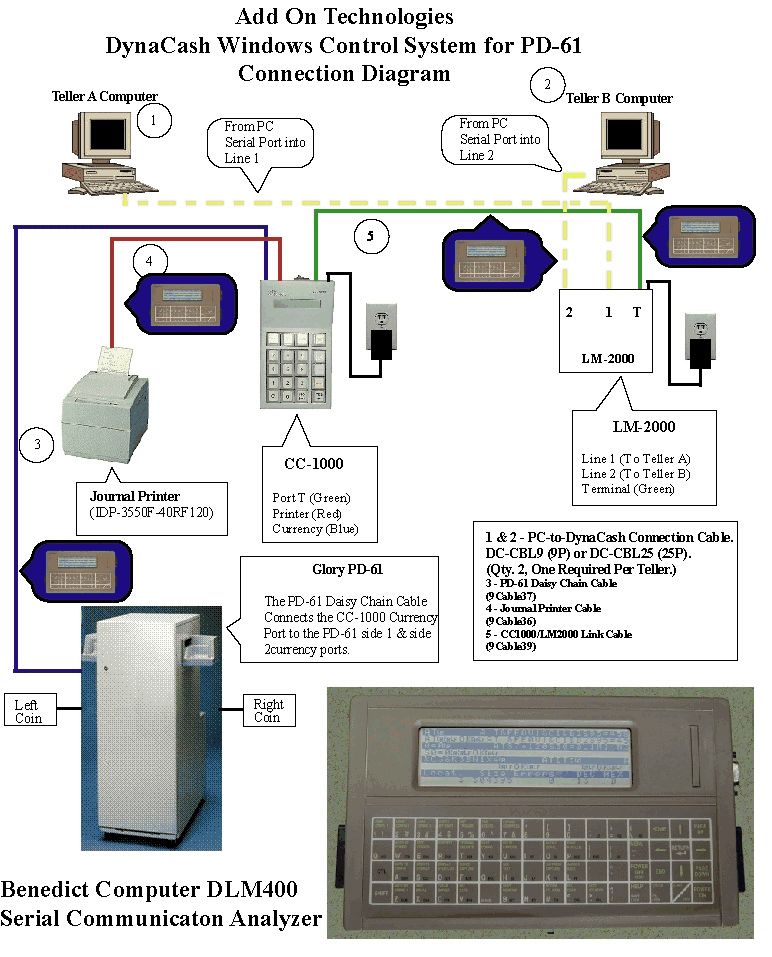
| Home | Product
Application Home |
Narrative |

| Simplifying
EMBEDDED SYSTEMS DESIGN Need an easy way to check new designs for faults and to monitor data and protocols? There’s a practical little hand-held tool out called a DLM400 (Benedict Computer, Williamsburg, VA), that does just that. This versatile device tests, monitors, and analyzes transmissions, allowing instrumentation, control, and automation design engineers to observe all traffic between the host CPU and the device at the other end of the RS232 (or similar) channel. The DLM 400 is an RS232, RS422, RS485, RS530 or MIL-188C data communications diagnostic and troubleshooting tool for designing embedded serial devices and drivers into host processors. With it, the developer views actual transmitted/received data along with associated channel and control signals. Easy to understand LCD prompts, and the supplied quick start set-up guide, allow even a novice user to turn on the DLM400, view and set up parameters, connect the unit to the channel for monitoring and display transmitted/received data and protocols within a few minutes. Design engineers find this device to be extremely useful during their development phase. A case in point is Add-On Technologies (Wingate, NC), builders of the DynaCash dispensing system -- a PC-to-automated cash dispensing system (i.e. an indoor ATM for improving security and productivity). As depicted on the accompanying diagram, the standard system consists of two Windows software front-end components (PCs) at a cashier or teller station that perform text capture tasks and record the Cash Back amount requested by the customers. Each PC then outputs the amount to the LM-2000 router, via the PCs’ serial ports. The router box merges the two serial port streams from the PCs into one stream for output to the CC-1000, which drives the cash dispenser unit. The CC-1000 also serves as a cash inventory control terminal, reporting to a journal printer on a per-transaction basis. In addition, it manages security (e.g., PIN numbers, cashier/teller numbers) for cash dispensing. According to system designer Ray Van Vynckt, “The DLM 400 is employed to monitor the complex protocols between our system and the cash dispensers during development of the embedded dispenser driver.” The diagram shows the insertion points where the DLM 400 is placed to monitor channel protocol activity between hardware units. HOW IT WORKS The unit’s operating panel consists of a full 64-key QWERTY keyboard plus PC style directional keypad. Labels on the keys indicate the operations to be performed. Three operating modes are available: Menu, View and Execute. The Menu mode provides the screen prompts to guide you through the monitoring procedure, parameter settings and function selection. View mode permits data and signal viewing. The data scrolls through the display at one of four selectable viewing rates. An expanded view option makes high-speed data transfers easier to see. The Execute mode is the “do” (activate) mode; that’s all there is to it, -- “It’s pretty simple to operate,” says Vynckt. . With the DLM 400, Design Engineers perform fault checking of embedded designs during the development phase, exercise hardware, and carry out response-time monitoring of data communications between the host and device. The unit is capable of observing transmitted and received data flow over sync or async lines. All prompts, menus, and configurable parameters are stored in a nonvolatile memory; factory set defaults or the latest user-defined selections are also safely stored for automatic recall. They can be viewed on the unit’s LCD, consisting of eight rows of 30/40 characters each. Transmit and Receive buffers hold a total of 1MB of data (over 304,000 records). Data capture selection can be continuous (discarding the oldest data or stopping when the buffers are full), or user-defined via a selected character string acting as a trigger to start the process. There are several modes and formats available for data viewing, with transmitted and received data simultaneously displayed on consecutive screen rows. The DLM400 can transmit several different data patterns for continuous output or BERT testing, and it utilizes any of five user-selected protocols. Baud rates from 75 – 115,200 bps (230,400 bps half-duplex) asynchronous and 75 to 64,000 bps synchronous are supported. Transmit and receive data are displayed simultaneously in various common formats, including the popular ASCII, EBCDIC, BAUDOT, and IPARS. This development tool weights only 23 ounces (including the battery) and measures 9.25 x 5.50 x 1.37 inches. The hand-held device can be operated from within its protective carrying case. Its nine-volt alkaline battery provides 10 hours of power, eliminating the need to locate an AC outlet, and makes the tool suitable for field use. The DLM 400 provides engineers an in-depth look into the communications line during embedded system development; all data transmissions and protocol signals over an RS-232, RS422, RS485, or RS530 line are observed. It is a developer’s tool for configuring new embedded software designs, data line monitoring and testing, and for general data communications troubleshooting and fault isolation. Use Case Schematic Home
|